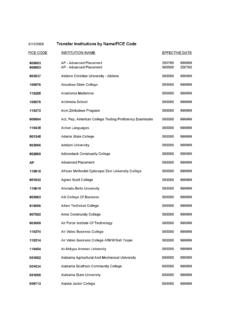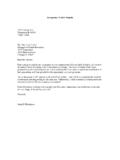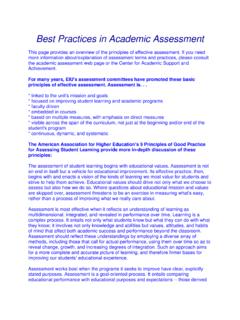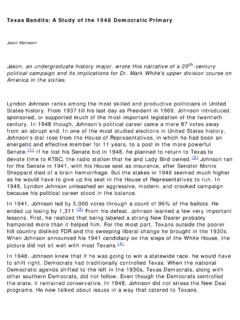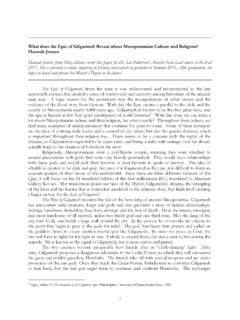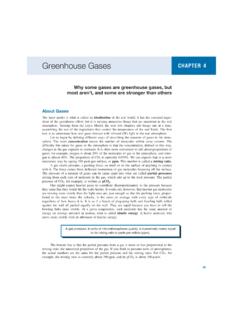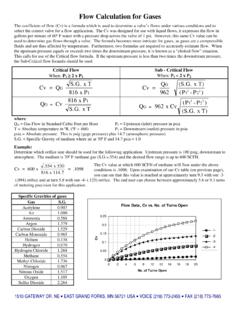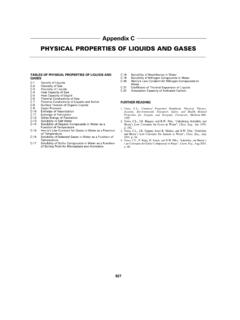Transcription of Tutorial 6 GASES - Eastern Illinois University
1 T-41 Tutorial 6 GASESB efore working with GASES some definitions are needed:PRESSURE: atmospheres or mm Hg; 1 atm = 760 mm HgTEMPERATURE: Kelvin, K, which is oC + 273 STP: Standard Temperature and Pressure: 273 K and 1 atm (or 760 mm Hg)BOYLE'S LAW (temperature is constant): PV = constantThis is an inverse relationship: if one variable increases the other ' LAW (pressure is constant): V = constant x T This is a direct relationship: if one variable increases so does the 'S LAW (volume is constant): P = constant x TThis is a direct relationship: if one variable increases so does the GAS LAW: PV = nRT, whereP = pressure of the gas sampleV = volume of the gas sampleT = Kelvin temperature of the gas samplen = moles of the gas sampleR = molar gas constantAVOGADRO'S LAW: At the same temperature and pressure, equal volumes of allgases have the same number of molecules. At STP one mole of any gas occupies avolume of L: this is the molar CHANGES: These are problems which involve only changes in the variables of Pressure,Volume, and Temperature.
2 The IDEAL GAS LAW can be rearranged to PV(1) = nR TT-42 For a fixed number of moles of gas the right side of this equation is constant. We can thenderive: P1V1 P2V2(2) = T1 T2where P1, V1, T1 are pressure, volume, and temperature for one set of conditions and P2, V2, T2for another. We use this relationship when changing a gas sample from one P-V-T state toanother. Solving equation (2) for the individual variables at the second conditions: P1V1T2 P1 T2(3)V2 = = V1 x x P2T1 P2 T1 P1V1T2 V1 T2(4)P2 = = P1 x x V2T1 V2 T1 P2V2T1 P2 V2(5)T2 = = T1 x x P1V1 P1 V1 Notice: the second value of the variable is the first value multiplied by fractions of the other : A gas sample occupies a volume of 125 mL at STP.
3 Calculate the volume of thegas at 25oC and 450 mm Hg are two ways of solving this problem: (a) blindly substitute values in equation (3), or (b) reason through. Let us do (b). Equation (3) is given below without numerical subscripts onthe P and T fractions: they are considered to be correction fractions: the second volume will bethe first volume multiplied by two correction fractions, one for pressure and one for pressure and temperature changes are:pressure change: 760 mm Hg 450 mm Hgtemperature change: 273 K 298 KThe effect of the pressure change alone is to increase the volume, since pressure and volumeare inversely related (BOYLE'S LAW). Therefore the correction fraction for pressure must makethe volume larger and is 760 mm Hg / 450 mm , the temperature change alone will increase the volume, since volume andtemperature are directly proportional (CHARLES' LAW). Therefore, the correction fraction fortemperature must make the volume larger and is 298 K / 273 solved problem looks like this: P T 760 mm Hg 298 KV2 = V1 x x = 125 mL x x = 230 mL P T 450 mm Hg 273 K correction fractions In many problems only one variable changes; these problems are much easier to : A gas sample has a pressure of 742 mm Hg at 25o C.
4 Calculate the pressure of thegas at 100o of blindly substituting in equation (4) let us reason. Equation (4) is given below withoutnumerical subscripts on the V and T fractions: they are simply considered to be correctionfractions: the second fraction will be the first multiplied by two correction fractions, one forvolume and one for temperature. No mention is made of the gas volume so we assume it isconstant and the volume correction fraction is not temperature changes from 298 K to 373 K; this temperature increase will increase thepressure (GAY-LUSSAC'S LAW). Therefore the correction fraction for temperature must makethe pressure larger and is 373 K / 298 K. The solved problem looks like this: V T T 373 K P2 = P1 x x = P1 x = 742 mm Hg x = 929 mm Hg V T T 298 K MASS-VOLUME RELATIONSHIPS: PVT problems work for any gas.
5 If we want to know thevolume of a given mass of gas, or the mass of a given volume of gas, then we must consider a specific gas; the mass of 100 mL of oxygen is different from the mass of 100 mL of must first evaluate R, the molar gas constant. Solve the IDEAL GAS LAW for R andsubstitute known values for n, P, V, and T: one mole of a gas occupies L at 1 atm and 273 K: PV (1 atm)( L) L-atmR = = = nT (1 mol)(273 K) mol-KorT-44 PV (760 mm)( L) mm-LR = = = nT (1 mol)(273 K) mol-KNotice there are four units on this : Calculate the volume of g of oxygen at 25oC and 742 mm Hg convert the mass of oxygen to moles of oxygen: 1 mol g O2 x = x 10 3 mol O2 g O2 Then solve the IDEAL GAS LAW for volume.
6 (The units must correspond to the units of the Rthat is used.) mm-L ( x 10 3 mol)( )(298 K) nRT mol-KV = = = L P (742 mm)or L-atm ( x 10 3 mol)( )(298 K) nRT mol-KV = = = L P 1 atm (742 mm x ) 760 mmEXAMPLE: Calculate the mass of 335 mL of sulfur dioxide measured at 37oC and 745 mm IDEAL GAS LAW does not have a mass unit but it has a mass related unit: mol. Therefore,solve for n and subsequently convert to grams: PV (745 mm)( L)n = = = mol SO2 RT mm-L ( )(310 K) mol-KT-45 g SO2 Mass SO2 = mol SO2 x = g SO2 1 mol SO2 GAS DENSITY: The density of a gas can be computed from its molar mass and its molarvolume under a given set of are typically about three orders of magnitude (1000 times) less dense than liquids (atordinary temperatures and pressures).
7 For convenience, gas density is reported in units of g/Lrather than the customary g/mL or g/cm3 unit that is used for liquids and : Calculate the density of carbon dioxide at know that at STP one mole of any gas occupies L (AVOGADRO'S LAW). Thus: molar mass g CO2 / mol D = = = g/Lmolar volume L CO2 / mol EXAMPLE: Calculate the density of carbon dioxide at 100oC and 850 mm these P-V-T conditions the molar volume is not L. However, we can calculate themolar volume at these conditions. Starting from STP:pressure change: 760 mm Hg 850 mm Hg temperature change: 273 K 373 KSetting up the appropriate correction fractions for P and T, the molar volume at the conditions ofthe problem is: 760 mm Hg 373 KVmolar = L x x = L 850 mm Hg 273 KThe density may now be calculated: molar mass g CO2 / mol D = = = g/Lmolar volume L CO2 / mol WET GASES : DALTON'S LAW states: in a mixture of GASES the total pressure is equal to thesum of the pressures of all GASES present:T-46 Ptotal = P1 + P2 + P3 +.
8 When a gas is collected over water there is water vapor in the gas volume. According toDALTON'S LAW, the total pressure is:Ptotal = Pgas + PwaterFrom which,Pgas = Ptotal - PwaterThe total pressure, Ptotal, is usually an experimentally determined quantity. The pressure of thewater, Pwater, is the vapor pressure of water. Vapor pressure of water at various temperatures isavailable in tables, such as Appendix B, p 1018, in your lecture text. (A vapor pressure table isalso posted in each lab.) To obtain the gas pressure, subtract the vapor pressure of water fromthe total : A 325 mL sample of gas is collected over water at 26oC and 742 mm Hg pressure. Calculate the volume of the dry gas at STP. The vapor pressure of water is 25 mm Hg at first find the pressure due to the gas alone by subtracting the vapor pressure of water:Pgas = Ptotal Pwater = 742 mm Hg 25 mm Hg = 717 mm HgWe then find the volume at STP by multiplying by appropriate correction fractions: P T 717 mm Hg 273 K V2 = V1 x x = 325 mL x x = 280 mL P T 760 mm Hg 299 K T-47 1)A sample of nitrogen is heated from STP to 100oC at constant pressure.
9 Calculate thevolume at 100oC. 2)A sample of helium is heated from STP to 100oC at constant volume. Calculate thepressure at 100oC. 3)A sample of argon is heated at constant volume from STP until the pressure is 1250 mmHg. Calculate the temperature. 4)A 300-mL sample of sulfur dioxide is cooled from 250oC to 125oC. Calculate the volume. 5)A sample of chlorine at atm pressure is cooled from 100oC to 0oC. Calculate thepressure. 6)A gas is heated at constant pressure from 25oC until its volume increases from 120 mLto 175 mL. Calculate the final temperature. 7)A 325-mL sample of nitrogen is at a pressure of 500 mm Hg. The pressure is changeduntil the volume is 150 mL. Calculate the final pressure. 8)A 325-mL sample of nitrogen is cooled from 250oC until its volume is 275 mL. Calculatethe final temperature. 9)The pressure on a 500-mL sample of gas is changed from atm to atm. Calculate the )A sample of oxygen occupies a volume of 437 mL at 25oC and 735 mm Hg pressure.
10 Calculate the volume at )A gas sample occupies a volume of 125 mL at 100oC and 500 mm Hg pressure. Calculate the volume at 250oC and 1750 mm Hg )A 500-mL sample of oxygen has a pressure of 450 mm Hg and a temperature of 100oC. Calculate the pressure when the volume is 700 mL and the temperature is )A gas occupies a volume of 225 mL at STP. Calculate the temperature needed tochange the volume to 300 mL and the pressure to 1000 mm )A 455-mL sample of gas is obtained at 26oC and 742 mm Hg pressure. What will be thepressure when the volume is 600 mL and the temperature 40oC?15)A gas occupies a volume of 500 mL at 100oC and 500 mm Hg pressure. Whattemperature is needed to change the volume to 450 mL and the pressure to 300 mmHg?16)Calculate the volume of g of oxygen at )Calculate the volume of g of chlorine at 32oC and 500 mm )Calculate the mass of 155 mL of helium measured at )Calcualte the mass of 500 mL of xenon measured at 25oC and 555 mm )Calculate the mass of 250 mL of argon measured at 100oC and )What volume of hydrogen, measured at 25oC and 740 mm Hg, will be formed from thereaction of g of zinc metal with excess hydrochloric acid?
